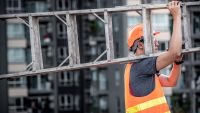Cal/OSHA to Adopt Federal Silica Standard
Public hearing to be held August 18
By Julie Trost
On August 18, Cal/OSHA will hold a public hearing in Walnut Creek to hear comments on its intention to adopt the federal silica standard released in March of this year.
The federal final rule is written as two standards, one for construction, and one for general industry and maritime. The regulation lowers the permissible exposure limit (PEL) for crystalline silica from 250 micrograms per cubic meter of air to 50 micrograms per cubic meter of air (.05 mg/m3), averaged over an eight-hour shift. It also requires employers to use engineering controls and work practices to limit worker exposure, provide respiratory protection when controls do not limit exposures to the PEL, limit access to high exposure areas, train workers, and provide medical exams to highly exposed workers.
So, here’s the rub: California’s current PEL is 100 micrograms per cubic meter of air (0.1 mg/m3). The new federal standard of 50 micrograms per cubic meter of air (.05 mg/m3) is 50% of the current California standard!
But, there’s more. Current Labor Code mandates that state regulations be at least as effective as federal regulations addressing occupational safety and health issues.
California’s current standard was crafted by MCAC (then CCMCA) in partnership with an industry coalition and Cal/OSHA as a simple and effective 3-page regulation focused on engineering controls (as opposed to PEL monitoring) that would provide meaningful and measurable methods of protection and be user-friendly to the field personnel on the front lines. The state and federal standards differ in several major ways not the least of which is scope (federal regulation is 1,772 pages) and application along with the aforementioned PEL. Additionally, the current state standard lacks requirements for medical surveillance and a written exposure control plan.
The August 18 hearing will consider public input on the proposed California regulation to adopt the federal OSHA standard and deviations in three areas:
1. Identify any clear and compelling reasons for California to deviate from the federal standard; and,
2. Identify any issues unique to California related to this proposal which should be addressed in this rulemaking and/or a subsequent rulemaking; and,
3. Solicit comments on the proposed effective dates.
See the Cal/OSHA hearing notice and link to rulemaking documents here.
We will keep you apprised of developments on this important issue.
About the Author
Julie Trost is the Executive Director of the Mason Contractors Association of California, Inc.
















